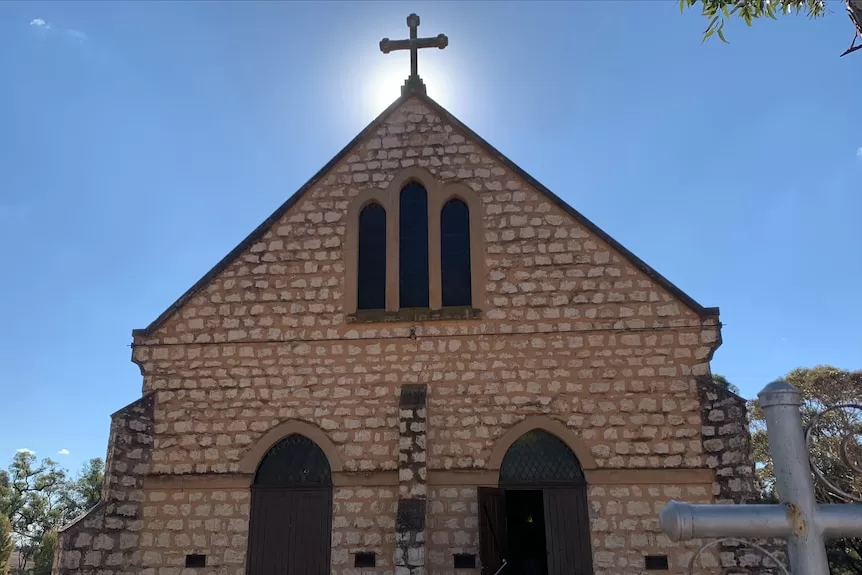If you head to the town of Pella, you’ll have to drive down a sandy road seemingly to the middle of nowhere.
But as you near the early 20th-century ghost town in the Mallee in Victoria’s north west, you might hear organ music rippling through the bush.
It emanates from an enormous 1878 pipe organ, which was moved up to Pella in the 1970s by the congregation.
The organ itself is housed in the tremendous St John’s Lutheran church, built by German-speaking immigrants in 1910.
Mal Drendel is the organist at St John’s and grew up on a farm nearby, and says that for as long as he can remember the church has been an icon.
“I played for weddings here, I’ve played for funerals here, on the organ. I can remember weddings back when I was a teen,” he says.
“It’s a tourist attraction … people come out here specifically to hear it or to sing to it.”
When those tourists do come, Mal says that they all have one thing to say: “Wow.”
“And then when you ask people how many pipes are in it, [498] they go ‘Wow’ again.
“[They say] ‘Why did they build it here? It’s out in the middle of nowhere, it’s not even on a road.'”
Why it was built in the middle of nowhere?
The few buildings at Pella were built by German and Polish settlers, who were the first Europeans to arrive in the area in 1899.
They named it “Pella” as an homage to the biblical city of Pella in Palestine, inspired by that city’s location between the Sea of Galilee and the Dead Sea and their town being founded between two creeks.
Almost all the settlers who bought land west of Outlet Creek were Lutheran.
Although most of them were Australian-born, Mal says they held on to their German heritage.
“Most of the people who came out here were already born in Australia so their language was English but [they] knew German because of their parents and ancestry,” he says.
“They moved over from South Australia, from the Barossa, and then came over to open up the Wimmera and the Western District and then the Mallee country when it opened.”
The German influence was so strong that until the 1930s both English and German were taught in the schoolhouse, which still stands.
That building, the church, and another small house are all that remain of Pella, although there used to be another dwelling across the road.
All of them were made with locally sourced stone, and fired onsite using special kilns.
“About another half mile out that way was where the stone was dug up and then burnt and then hardened and then carved into blocks and then built,” Mal says.
“The bloke who built the church was actually Polish, who came out with the Germans.”
Pulling out all the stops to move the organ
The most prized item of St John’s Lutheran Church is the famous organ, which stands 4.8 metres tall behind the pews.
It was built by hand in 1885 by Alfred Fuller, and originally installed at Howe Crescent Congregational Church in South Melbourne for a cost of £315 or about $52,000 today.
In the late 1960s, the congregation at Pella decided they needed a new organ, and seeing this one for sale, fundraised for it to be brought up.
Mal says it was transported to the church on the back of a truck.
“A local farmer drove down in his truck … and it was pulled apart in the church in South Melbourne and put on his truck and then brought up here, and then put back together again and restored,” he says.
Despite being almost 140 years old, the instrument works smoothly and has only had slight modifications made, such as an electrical air pump to replace a set of bellows that had to be worked by hand.
Mal learnt how to play the organ growing up.
“Like all the young kids back in the day, we learnt to play the piano by ear and really it’s just like playing a piano,” he said.
“The only thing you’ve got to figure out what stops to pull out, which is what makes the organ sounds. Each stop has a different sound, so you pull out one and then another one and then another one.”
“If you want to play the loudest you pull out all the stops.”
The keys still moving
Despite the area’s declining population, St John’s Lutheran Church still holds services every fortnight in conjunction with the parish at nearby Rainbow.
It is also a site for weddings, funerals, christenings, and even organ recitals before the pandemic.
Although it still is off the beaten track, Mel says that a small tourist trade did begin in the 1980s and 90s.
“Occasionally you get people from Europe coming through here but really they’re only just tourists who might be going around Australia or going around Victoria, and they get told about it [to] come and have a look,” he says.
“Like a normal church, you have your baptisms when you’ve got members who have their kids and the weddings. And funerals, which are happening, because we’re getting older.”
Yet he still says word of mouth is the best way to find Pella.
“If you want to come, ring me and I’ll go, ‘OK, I’ll meet you there.'”
